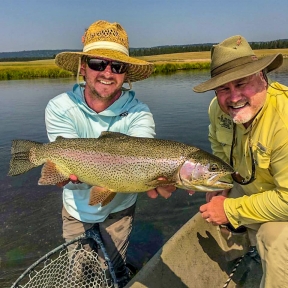
Upper Henry's Fork
Many anglers neglect the section of the Henry’s Fork above Island Park Reservoir. Recreational floating upstream from Coffee Pot Campground can sometimes conflict with fishing but you can still find good fishing, especially in the evening hours. There have been some good mayfly hatches. Normally the trout aren’t very selective so you can get by with traditional patterns like a #16 Parachute Adams, #16 Renegade and #16 Tan EZ Caddis. You’ll also catch trout with beadhead nymphs and wooly buggers.
Box Canyon
The Box produces some of the most consistent fishing throughout the season. Tactics, techniques and fly patterns remain relatively the same. You can catch trout with a hopper/dropper system but you’ll catch more trout when you stick to a double nymph system fished with an indicator or bobber. Use a #8 black or brown Rubberlegs dropped about 36 inches down from the indicator. From there attach a #16 red or olive Zebra Nymph, #16 Red 2-Bit Hooker or #16 olive or peacock Anato May Nymph. Streamers will also produce some large trout, especially in the mornings and evenings. I like a size 4 Woolhead Sculpin but there are lots of new innovative patterns that will do the job. I also like to add a 12 foot section of sinking leader to my fly line to help get the fly down.
Last Chance/Ranch/Pinehaven
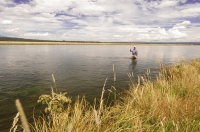
I honestly can’t remember a summer where more really large rainbows were caught on the Ranch. Trout 2 feet long or more was always a rarity for me even though some anglers said they caught Rainbows of that size on a regular basis. I think they used a different measuring stick than me. This year trout of that size have been much more common. Look for feeding fish in the morning hours. They’re usually taking spinners but there have also been some good hatches of small dark caddisflies. You can expect to find good spinner falls of Tricos and Callibaetis, especially in the slower stretch encompassing the middle Ranch. We’re also starting to see some Mahogany Duns which are always a welcome sight after straining your eyes trying to see a size 20 Trico imitation. You can get by with size 16 or 16 Mahogany Duns. My favorite pattern is a Mahogany No-hackle but parachutes and sparkle duns also work very well. Terrestrials are also very productive. There are size 14 Honey Ants and small black ants. Hoppers are also working very well. When in doubt of what fly to use, try a size 16 black beetle.
Lower Henry's Fork
The Warm River to Ashton stretch has been fishing well for numbers of small trout and whitefish but the larger trout have been a little more difficult. Use a hopper/dropper combo. Further down below Ashton the water temperature is holding cool enough for productive hopper fishing. Don’t expect a lot of trout but the ones you get to the fly are usually very impressive. Trico activity has been productive on the slow backwater areas further down from Ashton to St. Anthony.
Madison River
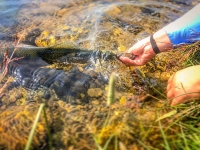
The fishing has been nothing to write home about but it is starting to improve with cooler temperatures and higher flows. Hoppers, ants and other terrestrials have been productive during the day. There are also nocturnal summer stoneflies which can produce very good dry fly fishing in the early morning or late evening hours. Look for the Madison to continue to improve during the upcoming weeks.
Teton River
Things have slowed on the lower Teton but fishing has been productive in the canyon section and the Upper Teton. Use hopper/droppers in the canyon. There have been some good mayfly hatches in the Teton Basin section of the river. Look for Tricos and PMD spinners in the morning. Later in the day use an attractor dry like a Chubby Chernobyl with a nymph dropper. We expect Mahogany Duns to start showing up soon. The upper river is a true spring creek with lots of smaller trout. It’s a great place to keep a few brookies if you like to eat fish. Yet there are some very large fish in this water but they are difficult to find and to fool
South Fork
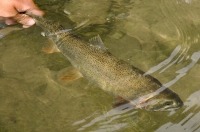
We’ve been getting some good dry fly fishing in the riffles. There are still some PMDs mixed with Pink Albert mayflies. Unless you get a very close look you really can’t tell these two bugs apart other than the PMD has 3 tails and the Pink Albert has two. Both have a pinkish tan body. We’ve also been getting some nocturnal summer stoneflies. These are very interesting insects. The males usually have very small wings with large strong legs. They scamper over the bank structure and into the water seeking a mate. Females have wings enabling them to fly over the water to deposit their wings. Best fishing is to use a foam pattern like an Elden’s Ant, cast to the bank, and twitch the fly slowly. Hoppers with nymph droppers have also been productive during the day.
Yellowstone Park
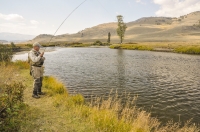
Right now the best fishing is on the Lamar River and tributaries like Slough Creek. There are two sections of the Lamar – the canyon section and the upper meadows. Attractor dry flies will take some nice trout in the canyon, especially the section below the highway 212 bridge. Use hopper patterns in the upper meadows. I like to walk to get away from the highway in the meadows but watch out for bison. If you see some bison, and there are usually plenty of them, give a wide birth. There aren’t many trees to climb and you can’t outrun them. They can be very dangerous, especially this time of year. The Yellowstone River is another option for large cutthroat but they are pretty tough to find this time of year. The hopper fishing from the West Entrance to the 9 mile bridge on the Madison has also been producing some nice fish.
Lakes
The gulper fishing has been productive on Hebgen Lake. The best fishing has been late in the morning if the water is calm. The trout are rising to Callibaetis spinners. There has also been some good flying ant activity. It’s more a matter of putting your fly in the right place in the trout’s feeding lane than pattern. You’ll do well with a size 16 Parachute Adams with a P T Nymph as a dropper 1 foot below the dry fly.